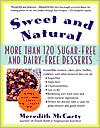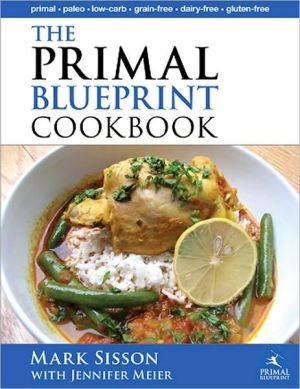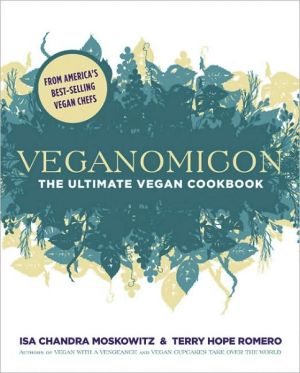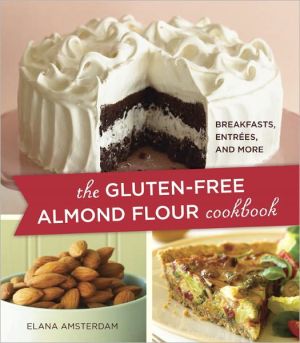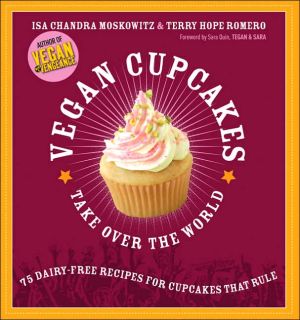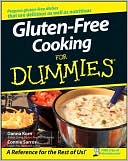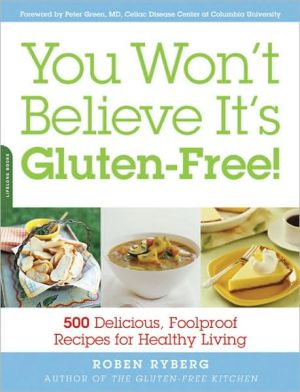Sweet and Natural: More than 120 Sugar-Free and Dairy-Free Desserts
Acclaimed natural foods chef Meredith McCarty brings together simple recipes for pies, cobblers, cakes, cookies, sorbets, and fresh-fruit desserts that are both healthful and delicious. Using fresh fruit, whole-grain flours, natural sweeteners, and light vegetable oils, the recipes range from home-spun classics to spectacular newcomers, including blackberry cobbler, chocolate-pecan bourbon bundt cake, peach and cherry pie, lemon-walnut tea cake, fresh plum galette, raspberry sorbet,...
Search in google:
Acclaimed natural foods chef Meredith McCarty brings together simple recipes for pies, cobblers, cakes, cookies, sorbets, and fresh-fruit desserts that are both healthful and delicious. Using fresh fruit, whole-grain flours, natural sweeteners, and light vegetable oils, the recipes range from home-spun classics to spectacular newcomers, including blackberry cobbler, chocolate-pecan bourbon bundt cake, peach and cherry pie, lemon-walnut tea cake, fresh plum galette, raspberry sorbet, orange-ginger oatmeal crunch cookies, fresh strawberry compote with orange-ginger syrup, and many more.Sweet and Natural is a must-have resource for anyone who wants or needs to eliminate unwanted fat, refined sugar, and cholesterol-and celebrate good health with great desserts.
\ \ \ \ Chapter One\ \ \ About the Recipes and\ Nutritional Analyses\ \ \ Ingredients are listed in order of use as described in the recipe, Ingredients within a class, e.g. sweeteners or liquids, are listed in order of preference in terms of taste, texture, and visual appeal, the favorite item being listed first, e.g. brown rice malt syrup, barley malt syrup, or pure maple syrup.\ The analyses following each of the recipes are calculated for the original recipe (not the variations) without optional ingredients, and are figured for the larger number of servings. The analyses were performed on the computer program Food Processor II from ESHA Research in Salem, OR. 1996. Additional data derives from The Nutritive Value of American Foods, USDA Handbook No. 456, The Complete Book of Food Counts by Corinne T. Netzer, and manufacturers' analyses (see Resources section).\ \ \ A NOTE ABOUT TECHNIQUE\ \ \ You don't have to be an experienced baker, cook, or food chemist to make great tasting desserts. Cooking is an art, not a science, imitative as well as creative, and more play than work. A recipe is a series of guidelines to inspire and support you in trying something new, not a rigid formula.\ To begin with, read the recipe once or twice, or until you can easily picture both the process and the final result. Inexperienced bakers are served well to follow recipes to the letter until certain techniques are mastered and you develop a feel for the ingredients. Do remember to test new recipes once or twice before you make them for guests. Then, when starting to design your own recipes, keep flavors clean and uncluttered by featuring only one or two dominant flavors.\ Prepare mentally and physically for cooking with your whole body, mind, and spirit. The ancient French cooking principle of mis en place refers to having all ingredients at the ready to help you work quickly. Before you start shopping and cooking, go through the recipe to be sure you will have all the ingredients and equipment on hand. Gather them together before beginning, then measure or chop ingredients to the recipe specifications.\ People get different results from the same recipe because of the way they measure ingredients and the real temperature of their ovens. Measure ingredients accurately. Use nested measuring cups for dry ingredients, liquid measuring cups with pouring spouts for liquid ingredients, and standard measuring spoons for small amounts of both liquid and dry ingredients. In this book, all measurements are meant to be level, ie. 1 teaspoon, 1 tablespoon, or 1 cup. Gently scoop the flour out of the bag. Try not to tap the cup or scoop or the flour gets packed down.\ Temperature is very important to the success of baking. Home ovens are often not well calibrated and may be many degrees off, which can spell disaster. Buy an oven thermometer and keep it on the middle or lower shelf. Preheat the oven for 20 minutes before baking. Be sure the oven maintains the desired temperature by referring to it occasionally before and during baking until you can rely on the accuracy of your equipment.\ Prepare your baking pans before you begin mixing ingredients. I prefer to line the bottom of the pans with baking parchment rather than brush them with a light vegetable oil.\ Taste, taste, taste. In the beginning, follow recipe quantities as stated, but also notice the flavor of the fruit that goes into a pie. It changes with the season and between varieties. Later, once you know the recipe, you may want to include a little more or less sweetener. Observe the moisture content of fruit as well. If apples are quite dry, add a little juice to a pie filling. If ingredients are wetter than normal, for instance if the pears are super-ripe, add more arrowroot powder.\ Taste nondairy milks (soy, almond, or rice milk) to be sure they are impeccably fresh. Once opened, oils and nuts and seed butters should be refrigerated to preserve their flavor. If using tofu, ensure freshness by pouring off the liquid in the container as soon as you return from the store, adding fresh water to refrigerate. Use tofu as soon as possible.\ To make baking quicker, assemble the dry and wet ingredients in separate bowls in advance, then combine them just before baking. Oils are listed before liquid sweeteners in the recipes because these sweeteners (brown rice syrup, FruitSource, barley malt, sorghum syrup, or honey) slide out easily from a measuring cup when oil has been used in it first.\ Avoid overmixing, which removes air from a cake or cookie batter and creates a tough texture. Handle cookie and pie doughs gingerly. Don't knead unless the recipe calls for it, and even then knead just a few times.\ One of the most important things to know is that a moist dough is always easier to work with—and lighter in the end—than a dry dough. If a pie dough comes out dry and/or crumbly because either too much flour or oil were added, discard the dough rather than struggling to incorporate more water after the dough is formed. It's only flour, oil, and water and therefore not too wasteful to start again. Avoiding frustration, you'll be a happier cook.\ Prepare garnishes such as mint sprigs, rose geranium leaves, or flowers ahead of time and store them in the refrigerator. Other topping choices are fresh fruits or berries, nuts, or chocolate or carob chips. Add the garnish as close as possible to serving time to ensure freshness, crispness, and vivid color.\ \ \ Ingredients\ \ \ WHOLE GRAIN FLOURS\ \ \ The vast majority of mankind may be described as grain-eaters and has always relied on a cereal as the basic staple of diet, with wheat and rice—and in America, maize—as the most important examples. According to the Oxford Book of Food Plants, some of our oldest crops, such as wheat and barley, seem to have come into cultivation in the Middle East between 8000 B.C. and 5000 B.C. In China, rice is recorded as a staple crop as far back as 2800 B.C.\ Wheat products are the staple food of a very large part of the human race, especially those of European descent, although they are also very important in the temperate parts of India and China. Rice, often constituting a very high proportion of the diet, is the typical staple food of enormous human populations in Asia. Maize (the global term for corn, the idiom used in the United States) either is or was a staple food for large populations in South America, parts of eastern Europe, and in eastern and southern Africa.\ \ \ Health Concerns\ Whole grains are good sources of complex carbohydrates, fiber, B-complex vitamins, vitamin E, the minerals calcium, iron, magnesium, phosphorus, and potassium, and essential fatty acids. Organically grown grains and freshly ground flours are best in terms of flavor and nutrition from the bran and the germ, both of which satisfy the need for large amounts of oil or butter.\ In terms of baking to create vibrant health, whole grain flours are the key. In a six-year study of 65,000 women done by the Harvard School of Public Health, those whose diets were high in carbohydrates from white bread, white pasta, and white rice (all refined grain products) and potatoes, had two and a half times the risk for Type 2 diabetes as those who ate a diet rich in high-fiber foods like whole wheat bread, whole grain pasta, and brown rice.\ Walter Willet, a Harvard professor of epidemiology and nutrition and a coauthor of the study, finds the results of this and other research so convincing that he'd like to see the government amend the Food Guide Pyramid, which recommends six to eleven daily servings of any kind of carbohydrate. "What's important in the diet is not just the total amount of carbohydrates but the type of carbohydrate, and the Food Pyramid is remiss in not pointing that out. They should move white bread and potatoes up to the sweets category because metabolically they're basically the same ..."\ Diabetes is no minor concern. A chronic illness without a cure, diabetes is the fourth leading cause of death by disease in the United States. And it's a growing problem. Scientists predict that by 2007 more than 21 million Americans—about one in every ten adults—will have Type 2 diabetes, the kind that people in their forties and older may develop.\ \ \ Flours in Baking\ Flour forms the framework for whole grain pastries. High-protein flour is great for forming the strong elastic bonds of gluten that give bread its structure, but it makes for a tough cake or cookie. Choose low-protein soft wheat flour called pastry flour, with its higher percentage of carbohydrates, to produce a delicate crumb. Pastry wheat is not a finer grind of bread wheat flour. It is a completely different grain. Whole wheat pastry flour contains 100 percent of the whole wheat berry.\ By marrying whole grain flours with white flours, you can create baked desserts with body as well as beauty. I have used unbleached (white) pastry flour in many of the recipes in a proportion of no more than 50 percent of the volume of flour, but if you prefer, all whole wheat pastry flour may be substituted. There are some benefits to flours ground from just the endosperm that don't contain the germ or bran. Doughs made from even some white flour will enjoy greater expansion creating lighter desserts. The bran, no matter how finely ground, has sharp edges that tend to shred the strands of gluten that have been developed in a dough or batter. When the gluten matrix is torn, some of the carbon dioxide bubbles created by the leavening agent escape, resulting in a slightly denser baked dessert.\ Whole grains that are ground into flour, thereby rupturing the oily germ of the berry and exposing it to air and oxidation, slowly become rancid over a three-month period in a cool, dry place or six months in the refrigerator when stored in an airtight container, longer in the freezer. The best bet is to buy small amounts often and use them up right away. White flour, on the other hand, can be stored in a cool, dry place for an indefinite period of time.\ The other reason to include at least half whole wheat pastry flour is that when it is refined, white flour loses about 70 percent of its nutrients.\ \ \ Chemicals and Enrichment\ Choosing organic flours both supports sustainable agriculture and eliminates concern over the chemicals used in growing and processing white flour. All-purpose flour from the supermarket contains bleached, presifted wheat flour with malted barley flour and is enriched with niacin (a B vitamin), iron, thiamine mononitrate (vitamin B1), and riboflavin (vitamin B2). Self-rising flour or cake flour is the same as all-purpose flour with leavening (baking soda, sodium aluminum phosphate, monocalcium phosphate), salt, and calcium sulphate added.\ Bleach alters the protein in the flour and destroys the all-important carotene pigments that are essential to making a nice-looking baked good. It is the pigments that carry the delicate, nutty flavor and aroma of wheat-based pastries.\ Chemicals such as chlorine dioxide, benzoyl peroxide, and chlorine gas, all of which whiten and oxidize flour, are currently permissible additives. Cake flours are by definition heavily bleached, since an effect of bleaching is to "strengthen" or toughen the gluten so that a batter made with a bleached cake flour will be able to support the large amounts of sugar and fat that are usually part of cake formulations. High-quality pastry flour, on the other hand, is never bleached as untreated gluten is more tender and, handled gently, will produce a more tender and flaky result.\ And according to "The Baking Sheet" from King Arthur Flour, "Although some `experts' rationalize that these chemicals are virtually dissipated by the time the flour is used, we have it on the authority of one of our labs that both benzoyl peroxide and chlorine gas leave chemically detectable residues in the flours that are treated with them ... that can be detected as bitter aftertastes ... Chemical additives are designed to mask and artificially compensate for desired characteristics that are lacking in lower-grade flours."\ Other additives include potassium bromate, an oxidizer and conditioner, and enrichment. Potassium bromate has come under increasing scrutiny as tests with it have indicated that it is potentially carcinogenic. As for enrichment, more nutrients are returned to the flour than would naturally exist. And there is controversy as to whether synthetic vitamins and minerals are beneficial or toxic. Dr. John McDougall says in The McDougall Plan: "Processing and refining results in new and often undesirable properties for individual components because they are more concentrated and are no longer associated with the minerals, vitamins, fiber, fats, carbohydrates and proteins that surrounded them when present in the natural food."\ \ \ Wheat Alternatives\ Nowadays many people are looking for recipes that feature grains or starches other than wheat (such as brown rice, millet, quinoa, or chestnut flours, or arrowroot powder). Spelt is an original strain of bread wheat to which many wheat-sensitive people are not reactive.\ Wheat (and its relatives spelt, kamut, and triticale), rye, barley, oats, and buckwheat contain gluten to which some people with a yeast-related health problem are allergic or sensitive. The last three barley, oats, and buckwheat—contain a gluten analogue to which some sensitives are not reactive.\ Making muffins and crisp and cobbler toppings is a good way to see how the flours react in combination with the other ingredients used in baking. While doing so, it became clear that all flours make leavened baked goods on their own, but most have textures—either somewhat crumbly and dry or dense and gooey—that are best combined with wheat, a wheatlike flour (ie. spelt, kamut, or triticale), or with other gluten grains.\ On the other hand, any flour may be used in a crisp topping since the ingredients, containing no leavening agent, are simply mixed for a sandy streusel consistency.\ For gluten-free toppings, substitute the gluten analogues or gluten-free grains such as chestnut or quinoa flour as a base. Include the other gluten-free grains—rice, millet, corn, amaranth, and teff—in smaller amounts because they make very crumbly baked goods that do not hold together well when used alone. See the Wheat-Free Basic Vanilla Cake recipe on page 166.\ If a particular flour cannot be found in your natural foods store, make some fresh flour from whole grains by grinding them in a grain mill (most effective), coffee mill or spice grinder, a mini-prep food processor or a small blender container. Or grind flakes such as wheat, barley, or kamut flakes into flour. I have used commercially milled flours in this book because that is what is available to most people. Should you decide to grind your flours fresh, they may require up to 25 percent less liquid than commercially milled flours.\ All flour should be refrigerated directly after grinding because it may lose 40 percent of its nutritional value within one to three days after it's ground. That is the major advantage of being able to grind grains fresh, either at the store or at home. So keep your flour refrigerated and suggest that your natural foods store does the same. If any flour doesn't taste good to you, consider the possibility that it has gone rancid.\ \ \ Whole Wheat Pastry Flour\ This flour is the one used most often in this cookbook. Also called soft wheat or soft white wheat, both whole grain and white pastry wheat flour are lower in gluten content than whole wheat bread flour. Pastry wheat flour makes for light, delicate pastries.\ \ \ Spelt\ Spelt, which today is officially classified as a subspecies of common wheat, was one of the first grains to be domesticated. Archaeologists believe it was cultivated in parts of Europe during the Stone Age and in England by about 1000 B.C.\ In baking, both whole spelt and white spelt flours are slightly heavier than pastry flour and are very suitable for use in desserts.\ Nutritionally, spelt grain surpasses wheat in protein content, amino acids, minerals, and B vitamins. Its genetic makeup is different from today's wheats and it is not hybridized, so some wheat-sensitive people tolerate spelt well. Experiment with care and caution.\ \ \ Barley\ Barley was the most important bread-making grain of the ancient Greeks, Romans, and Hebrews. Today's barley flour is white and fluffy to the touch and tastes bland because the flour is made from "pearled" barley, "pearling" being a process that removes most of the bran layers. If barley flour is hard to find, you may decide to grind your own in a coffee grinder from barley flakes.\ The best choice as a base for wheat-free toppings, barley flour is closest to white pastry wheat flour or white spelt flour in both appearance (light buff color) and texture (fine-grained on the inside with a delicate crunch on the outside in cobblers). It is great in cookies combined with oat flour. Baked alone in muffins, the texture is thick and gummy.\ \ \ Quinoa\ Pronounced KEEN-wa, this was the staple grain of the Inca civilization more than 5,000 years ago and, until the Spanish conquest, was one of their principal foods along with maize (corn) and potatoes. Imported quinoa is grown in Ecuador, Bolivia, and Peru. Domestic quinoa is grown in the Colorado Rockies.\ Quinoa is a complete protein. In fact, quinoa was named one of the world's most promising foods by the National Academy of Sciences because of its high ratings for protein, calcium, iron, and fiber.\ As a gluten-free alternative to wheat, quinoa flour works well in baking as the base. It makes a lovely cake, but the flavor is somewhat strong when used in large proportion. The Quinoa Corporation spokesperson says that this is the natural flavor, that the grain has been desaponized—"water-washed, sun-dried, and cloth-brushed"—before it is ground into flour. To make your own quinoa flour, rinse, drain, dry roast in the oven, and then grind the grain.\ \ \ Oat\ Tan in color with great flavor and a delicate, fine-grained texture, oat flour adds a moist sweetness to baked goods when combined with other flours, especially wheat or barley, brown rice, and millet flours. Its texture is a bit viscous when used alone.\ \ \ Brown Rice\ This flour is surprisingly nice used by itself in baking—spongy texture, light color, pleasant taste. It makes for a slightly wet batter, calling for less liquid (see the Brown Rice Cake recipe on page 167). Its crystalline texture adds a crisp quality to pie crusts, crisp toppings, and cookies when used in combination with other flours such as wheat or barley, quinoa or chestnut.\ \ \ Millet\ Millet is considered one of the least allergenic and most easily digested of all the grains. It has a high protein content, a good mineral content, and is rich in lecithin. The slightly dry and crunchy texture of this pretty yellow flour makes it best combined with other flours like wheat or barley or quinoa.\ \ \ Kamut\ Wheats of this type originated in the fertile crescent area that runs from Egypt to the Tigris-Euphrates valley. The American growers coined the trade name, kamut, an ancient Egyptian word for wheat.\ Kamut is higher in vitamin, mineral (especially magnesium and zinc), and protein content than common wheat. It doesn't yield as well as wheat, but it is drought-resistant and performs well without chemical inputs.\ Kamut has a very nice texture and taste in baked goods. Muffin batters made from kamut call for more liquid because it is somewhat denser and drier than spelt flour. The resulting texture is spongy like bread.\ \ \ Chestnut\ For historic information on the American chestnut, see the Chestnut Cake recipe on page 192. More like a grain than a nut, chestnut flour is high in starch/carbohydrates, protein, B-complex vitamins, and minerals, and is low in fat.\ Chestnut flour's light tan color turns a milk chocolate-brown with baking. Chestnut flour adds sweetness with a hint of chocolate flavor as well as lightness and creaminess to baked goods. Too soft to stand alone, it's great combined with wheat, spelt, barley, oat, buckwheat, quinoa, or millet flours.\ Available in Italian markets or gourmet/specialty markets during the holiday season, see Resources on page 247 for an organic source.\ \ \ Buckwheat\ Not technically a grain, but a member of the rhubarb family, buckwheat is considered a grain due to the large number of edible seeds produced.\ Buckwheat contains a starchy substance known as a gluten analogue, which means it behaves like grain gluten in cooking, but for many people who can't tolerate gluten grains, buckwheat is not seen as poison to the body.\ The gray-blue flour darkens to a tweedy color with baking. Buckwheat has a pleasing flavor and stands up well on its own as the base for a wheat- and gluten-free cake.\ \ \ Cornmeal and Corn Flour\ Bright yellow or gray-blue in color; yellow cornmeal has a very gritty texture, making it best used in small amounts. Blue cornmeal and yellow corn flour are more desirable.\ (Continues...)\ \ \ Excerpted from Sweet & Natural by MEREDITH McCARTY. Copyright © 1999 by Meredith McCarty. Excerpted by permission. All rights reserved. No part of this excerpt may be reproduced or reprinted without permission in writing from the publisher. \ \ \ \
AcknowledgmentsixPrefacexiIntroduction1About the Recipes and Nutritional Analyses7Ingredients10Whole Grain Flours10Natural Sweeteners16Dairy & Its Alternatives27Vegetable Oils34Thickening Agents39Leavening Agents43Salt46Fruit50Seasonings51Chocolate & Carob52Edible Flowers54Appliances, Cookware, & Supplies55Fresh Fruit Desserts57Sorbets77Pies & Tarts91Crisps & Cobblers140Cakes, Tea Breads, & Muffins158Cookies204Puddings225Nut Milks, Pastes, & Creams240Resources247Bibliography253Index256
